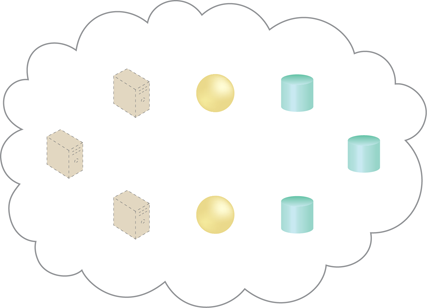Cloud Computing Patterns, Mechanisms > Basics > Basic Concepts and Terminology > IT Resource
IT Resource
An IT resource is a physical or virtual IT-related artifact that can be either software based, such as a virtual server or a custom software program, or hardware-based, such as a physical server or a network device (Figure 1).

Figure 1 – Examples of common IT resources and their corresponding symbols.
Figure 2 illustrates how the cloud symbol can be used to define a boundary for a cloud-based environment that hosts and provisions a set of IT resources. The displayed IT resources are consequently considered to be cloud-based IT resources.

Figure 2 – A cloud is hosting eight IT resources: three virtual servers, two cloud services, and three storage devices.
Technology architectures and various interaction scenarios involving IT resources are illustrated in diagrams like the one shown in Figure 2. It is important to note the following points when studying and working with these diagrams:
- The IT resources shown within the boundary of a given cloud symbol usually do not represent all of the available IT resources hosted by that cloud. Subsets of IT resources are generally highlighted to demonstrate a particular topic.
- Focusing on the relevant aspects of a topic requires many of these diagrams to intentionally provide abstracted views of the underlying technology architectures. This means that only a portion of the actual technical details are shown.
Furthermore, some diagrams will display IT resources outside of the cloud symbol. This convention is used to indicate IT resources that are not cloud-based.
Note
The virtual server IT resource displayed in Figure 1 is further discussed. Physical servers are sometimes referred to as physical hosts (or just hosts) in reference to the fact that they are responsible for hosting virtual servers.

